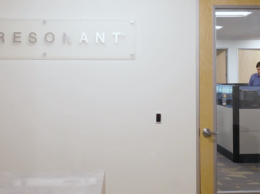Resonant taps $16.2M for Skyworks deal
IN THIS ARTICLE
- Latest news Topic
- Stephen Nellis Author
By Stephen Nellis Friday, June 6th, 2014
Santa Barbara-based semiconductor firm Resonant, which has a key development deal with a major supplier to the mobile phone industry, has raised $16.2 million in an initial public offering.
The company began trading on the Nasdaq under the symbol RESN after selling 3.1 million shares at $6 a share. By midday May 29, Resonant’s first day of trading, shares had hit $9 before settling into the $8 range at press time on June 4. The deal netted Resonant $16.2 million after fees to underwriter MDB Capital Group, which exercised its over-allotment options, a sign of strong demand for the shares.
Resonant has a new design for a mobile phone component called a duplexer, and its IPO builds on a $7 million private placement that it raised last summer.
The company is a spinout of Superconductor Technologies, a firm that was working on materials to transmit electricity more efficiently before it moved its headquarters to Austin, Texas, in 2012. Resonant’s duplexer sits at the very front end of a phone’s communications path, between the analog antenna and digital parts of the phone. It is a set of filters to select which radio frequencies to use for sending and receiving signals and to block unwanted signals.
Current duplexers can handle only a set number of frequency bands at a time, meaning each band requires a separate chip inside a phone. Resonant’s design is electronically tunable, meaning one chip would be able to replace several.
“Every time you add a channel, the way these things are done now, you have to add another duplexer to the front end of the phone. Some of these high-end phones now have as many as 20 of these things in them,” CEO Terry Lingren told the Business Times. “That’s a huge problem.”
And it’s a problem that’s set to get worse as governments around the world are working to free up more of the broadcast spectrum for use by mobile data devices. In the United States, the Federal Communications Commission is planing to purchase broadcast spectrum rights from the television stations that currently hold them and re-auction them to wireless companies such as AT&T and Verizon for use in data networks.
“That’s what we’re addressing — how to make use of this increasing amount of spectrum. The Internet is basically wireless now,” Lingren said. Cisco, the massive networking gear maker, estimates that “by next year, the amount of wireless data moving will surpass the amount of wired data,” he said.
Resonant is a development-stage company that doesn’t yet have significant revenues and has not built a commercially viable device with its design. However, it is has a development agreement with Skyworks, which supplies components for the Apple iPhone and many other mobile devices, and plans to have a production-ready device by the end of this year.
“Skyworks is the biggest player in their marketplace,” Craig Ellis, co-director of research with B. Riley & Co., told the Business Times earlier this year. “Their use of a technology would have the potential to be big.”
Skyworks, which did not return a request for comment for this story, has as much as 45 percent of the duplexer market for mobile phones investing heavily in filtering technology. In April, it signed a $148.5 million joint venture with Panasonic to develop radio-frequency filters.
The bonanza of interest in filters comes because the current technology is very old and is, in some senses, a highly refined version of the quartz crystal radio that grade-schoolers build as science projects. “The designs started way back in the 1920s with quartz crystal filters,” Lingren said. “Because it’s an elegant design, it has been good enough. Now with the explosion of bands and channels, they can’t even fit these small filters into the phones anymore.”
Though its technology breakthrough is the ability to tune to different bands, Lingren said the first product being developed for Skyworks is a single-band design. The hope is to replace a relatively expensive three-dimensional chip design with a cheaper two-dimensional one.
“This first design is really a cost play. It will be a drop in replacement,” Lingren said.
In the meantime, Lingren said the cash will be used to bolster the company’s team of 15 people if needed and continue to work on its portfolio of 36 patents, 21 of which are issued and the rest of which are pending. And it puts the company in the position to raise cash rapidly if the development deal with Skyworks blossoms.
“We now are in the public markets, so we’ve got visibility and will start establishing a track record,” Lingren said. “This now gives us a couple of years, even if we don’t get revenues. This gives us a good runway.”










